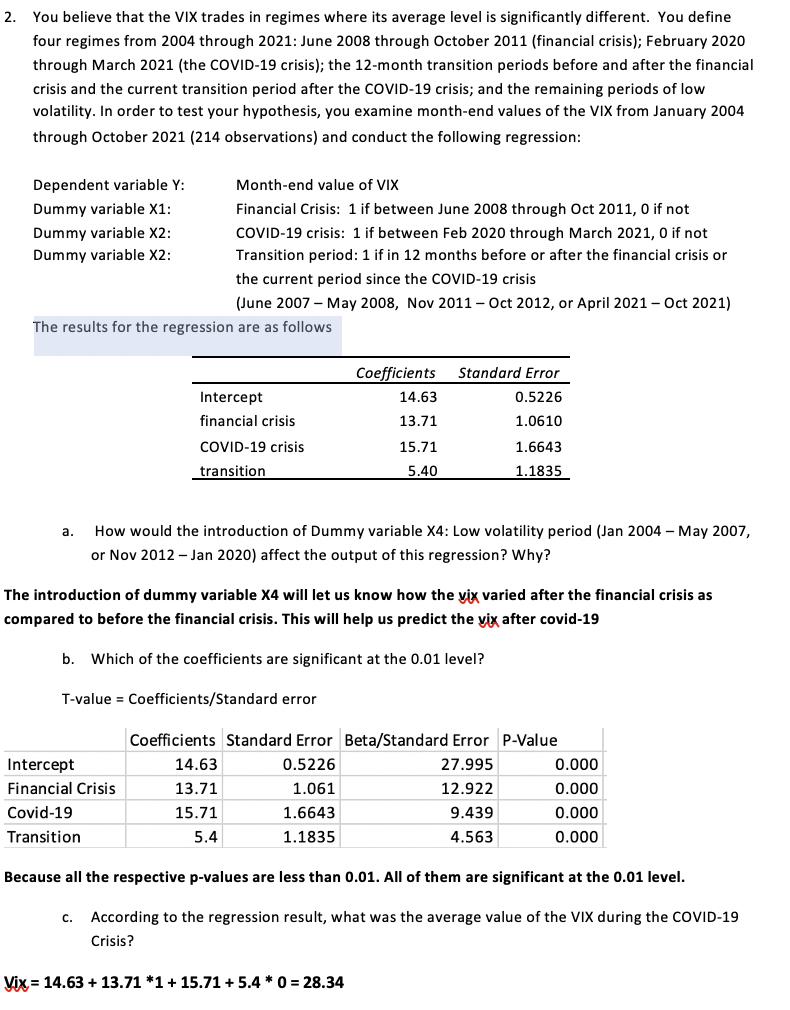In estimating the regression in problem #2, you are also concerned that the t-statistics may be inflated because of the presence of conditional heteroscedasticity. There are 214 observations and 3 independent variables.
In estimating the regression in problem #2, you are also concerned that the t-statistics may be inflated because of the presence of conditional heteroscedasticity. There are 214 observations and 3 independent variables.
Linear Algebra: A Modern Introduction
4th Edition
ISBN:9781285463247
Author:David Poole
Publisher:David Poole
Chapter4: Eigenvalues And Eigenvectors
Section4.6: Applications And The Perron-frobenius Theorem
Problem 25EQ
Related questions
Question
- ) In estimating the regression in problem #2, you are also concerned that the t-statistics may be inflated because of the presence of conditional heteroscedasticity. There are 214 observations and 3 independent variables.
You conduct a regression of the squared residuals against the dummy variables X1, X2, and X3 and find that for the squared residuals regression:
|
|
Multiple R |
0.4145 |
|
|
R Square |
0.1718 |
|
|
Adjusted R Square |
0.1600 |
|
|
SEE |
92.3760 |
- Conduct a Breusch–Pagan test at the 0.05 level to see if conditional heteroskedasticity is present and from your results, what needs to be done?

Transcribed Image Text:2. You believe that the VIX trades in regimes where its average level is significantly different. You define
four regimes from 2004 through 2021: June 2008 through October 2011 (financial crisis); February 2020
through March 2021 (the COVID-19 crisis); the 12-month transition periods before and after the financial
crisis and the current transition period after the COVID-19 crisis; and the remaining periods of low
volatility. In order to test your hypothesis, you examine month-end values of the VIX from January 2004
through October 2021 (214 observations) and conduct the following regression:
Dependent variable Y:
Month-end value of VIX
Dummy variable X1:
Financial Crisis: 1 if between June 2008 through Oct 2011, 0 if not
COVID-19 crisis: 1 if between Feb 2020 through March 2021, 0 if not
Transition period: 1 if in 12 months before or after the financial crisis or
Dummy variable X2:
Dummy variable X2:
the current period since the COVID-19 crisis
(June 2007 – May 2008, Nov 2011 – Oct 2012, or April 2021- Oct 2021)
The results for the regression are as follows
Coefficients
Standard Error
Intercept
14.63
0.5226
financial crisis
13.71
1.0610
COVID-19 crisis
15.71
1.6643
transition
5.40
1.1835
а.
How would the introduction of Dummy variable X4: Low volatility period (Jan 2004 – May 2007,
or Nov 2012 - Jan 2020) affect the output of this regression? Why?
The introduction of dummy variable X4 will let us know how the vix varied after the financial crisis as
compared to before the financial crisis. This will help us predict the yix after covid-19
b.
Which of the coefficients are significant at the 0.01 level?
T-value = Coefficients/Standard error
Coefficients Standard Error Beta/Standard Error P-Value
Intercept
14.63
0.5226
27.995
0.000
Financial Crisis
13.71
1.061
12.922
0.000
Covid-19
15.71
1.6643
9.439
0.000
Transition
5.4
1.1835
4.563
0.000
Because all the respective p-values are less than 0.01. All of them are significant at the 0.01 level.
C.
According to the regression result, what was the average value of the VIX during the COVID-19
Crisis?
Vix = 14.63 + 13.71 *1+ 15.71 + 5.4 * 0 = 28.34
Expert Solution
This question has been solved!
Explore an expertly crafted, step-by-step solution for a thorough understanding of key concepts.
Step by step
Solved in 4 steps

Recommended textbooks for you

Linear Algebra: A Modern Introduction
Algebra
ISBN:
9781285463247
Author:
David Poole
Publisher:
Cengage Learning

Linear Algebra: A Modern Introduction
Algebra
ISBN:
9781285463247
Author:
David Poole
Publisher:
Cengage Learning